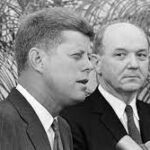Yoo-hoo, yoo-hoo — How the Peace Corps was established, Part 1
REMEMBERING THE CREATION OF THE PEACE CORPS ON
THIS MEMORIAL DAY WEEKEND
This is an early blog I posted on the website Marian Beil set up some thirty years ago. It focuses on the creation of the agency. JC
•
Yoo-hoo, yoo-hoo Peace Corps!
At the time of Shriver’s February 22, 1961 memorandum to President Kennedy — stating that the Peace Corps should be established as a semi-autonomous agency — there was a lot of professional resistance to the whole idea of sending young Americans overseas to do good. Career diplomats like Elliot O. Briggs described the Peace Corps’ team cry as “Yoo-hoo, yoo-hoo. Let’s go out and wreak some good on the natives,” as Wofford reports in his book, Of Kennedys & Kings [1992].
Throughout the State Department diplomats were indifferent to hostile to the whole idea of a Peace Corps. But not Dean Rusk, Kennedy’s new Secretary of State. He told Shriver —here with Kennedy — that he thought the Peace Corps idea was “first-class.” (Rusk’s sister, during my staff time in Ethiopia, would also be an APCD in the Empire.)
Henry Labouisse, was appointed in 1961 head of ICA (International Cooperation Administration, Eisenhower’s foreign aid agency that had a policy of massive capital investment accompanied by a few expert advisers, and that proven to be unsuccessful), and he feared that sending inexperienced “youngsters” into strange cultures would be inviting disaster and embarrassment. Labouisse wanted the Peace Corps placed under firm control of Kennedy’s new AID (Aid for International Development) program where its progress could be strictly monitored.
In late March of ’61 Shriver realized there was a problem with his vision of a “semi-autonomous” Peace Corps when he saw a draft of Kennedy’s speech on foreign aid and realized the President had sandwiched the agency inside of AID. He then attended a meeting at the White House and spotted a large chart of the new AID super-agency: the Peace Corps was off in a far corner, listed as a “resource.”
All of Kennedy’s aides: Goodwin, Ralph Dungan, and Sorensen said it only made “sense” to put the Peace Corps under the umbrella of the new AID. Kennedy, however, was still undecided, and Shriver got to him and the speech on foreign aid given on March 22 was vague about the Peace Corps, saying only that the new agency would have a “distinctive identity and appeal.”
Shriver thought he had “won” this battle with the White House, and the Peace Corps would emerge as a semi-autonomous agency in the new administration and be independent of AID, but Shriver was wrong.
In these first frantic days of creating the Peace Corps timing was everything. What mattered most was “who was in the White House Oval Office when a decision was being made.” The problem for the Peace Corps was that Shriver was not only not in the room, he wasn’t in the country.
According to Gerard Rice in his book, The Bold Experiment: JFK’s Peace Corps, Kennedy had told Shriver to visit Third World leaders and tell them about the Peace Corps “viability” in order to generate requests for PCVs. So Shriver went off around the world, and was in India when Henry Labouisse (who was against Shriver’s grand plans for the Peace Corps) was setting up a meeting for Kennedy to decide how all foreign aid programs would be incorporated into AID, including the Peace Corps.
The meeting was scheduled for April 26, 1961. On April 17, 1961, a force of 15,000 Cuban exiles landed at Cochinos Bay in southern Cuba. Now JFK had bigger problems than where the Peace Corps would find a happy home in his new administration.
•
PART ONE

John & Marian—thanks for recalling all of this. Until the pandemic we (RPCVs, congress, the country) took Peace Corps mostly “for granted’ It was there, it was basically a good thing and it is part of Americana. It is good to be reminded what a “near miss” it was—how it almost didn’t happen, almost was bureaucratically strangled in its crib, almost buried within USAID/State and almost started as a two year experiment with a hundred PCVs. We should all thank our lucky stars that Shriver and his allies (including Moyers, Lyndon Johnson & Barry Goldwater) stepped up and gave birth to one of America’s most innovative international policy programs of the 20th Century.
Thanks for our memories.
John and Marian,
So far as I know, the last seriously researched Peace Corps history book which covered Peace Corps programs worldwide was When the World Calls: The Inside Story of the Peace Corps and It’s First Fifty Years by the late Stanley Meisler which was published in 2011. It occurs to me that either of you could easily be writing such a book now as the new Peace Corps evolves.
Or Joanne Roll or Mr. Jefferson or Mr.Lihosit or as a team. But maybe this is being done already.
Thanks for thinking of me, Jim, but I’m already busy writing a novelette set in Scottsdale, Arizona during the early 1960’s. It has nothing to do with the Peace Corps. It’s about a kid’s basketball team from Yavapai Elementary School. The working title is Those Who Are Gone.